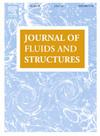Effect of corner modifications on galloping-induced response and galloping force of 3:2 rectangular section
IF 3.4
2区 工程技术
Q1 ENGINEERING, MECHANICAL
引用次数: 0
Abstract
Corner modifications play a significant role in influencing the galloping instability of rectangular sections, as highlighted in prior aerodynamic studies. This research focuses on the effects of various notched and chamfered corner modifications on the galloping behavior of a rectangular section with a side ratio of 3:2, offering a novel perspective by examining these modifications from an aeroelastic force standpoint. Wind tunnel experiments were conducted to simultaneously measure the galloping forces and displacements of the section under uniform flow. The results reveal that, similar to sharp-corner rectangular sections, the onset wind velocities of modified-corner sections deviate from the quasi-steady critical wind velocities for galloping and instead align with those associated with vortex-induced resonance. Among the modifications, notched corners are shown to be more effective than chamfered corners in reducing galloping amplitudes, with smaller notches significantly diminishing amplitudes and larger notches completely suppressing galloping divergence. Using a robust mathematical model for galloping forces, the underlying mechanism of the suppression effect due to corner modifications is elucidated. The superior suppression effect of notched corners, compared to chamfered corners, is attributed to their greater influence on high-order aerodynamic damping. This study extends previous findings by emphasizing the differences between sharp-corner and corner-modified rectangular sections, providing new insights into galloping mitigation strategies.
转角修正对3:2矩形截面驰动响应及驰动力的影响
在先前的气动研究中,弯角的变化对矩形截面的驰动不稳定性有重要的影响。本研究的重点是各种缺口和倒角修改对边长比为3:2的矩形截面的飞奔行为的影响,从气动弹性的角度研究这些修改提供了一个新的视角。进行了风洞实验,同时测量了均匀流动条件下截面的驰动力和位移。结果表明,与陡角矩形截面相似,修正弯角截面的起始风速偏离了准稳态驰动临界风速,而与涡激共振相关的临界风速一致。在这些改进中,缺口角比倒角更有效地减小了驰动幅度,较小的缺口显著减小了幅度,较大的缺口完全抑制了驰动发散。利用一种鲁棒的奔驰力数学模型,阐明了由于转角修正而产生的抑制效应的潜在机理。与倒角相比,缺口角的抑制效果更好,其原因在于缺口角对高阶气动阻尼的影响更大。本研究扩展了先前的研究结果,强调了尖角和角修改矩形截面之间的差异,为缓解飞驰策略提供了新的见解。
本文章由计算机程序翻译,如有差异,请以英文原文为准。
求助全文
约1分钟内获得全文
求助全文
来源期刊

Journal of Fluids and Structures
工程技术-工程:机械
CiteScore
6.90
自引率
8.30%
发文量
173
审稿时长
65 days
期刊介绍:
The Journal of Fluids and Structures serves as a focal point and a forum for the exchange of ideas, for the many kinds of specialists and practitioners concerned with fluid–structure interactions and the dynamics of systems related thereto, in any field. One of its aims is to foster the cross–fertilization of ideas, methods and techniques in the various disciplines involved.
The journal publishes papers that present original and significant contributions on all aspects of the mechanical interactions between fluids and solids, regardless of scale.
 求助内容:
求助内容: 应助结果提醒方式:
应助结果提醒方式:


